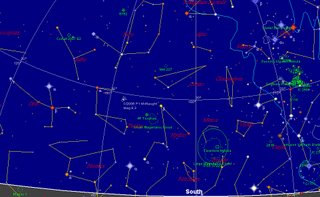Sunday, March 18, 2007
A new comet in Indus - Congratulations Terry Lovejoy!
 Star chart of the Southern skies at 5:50 am ACST showing Comet Lovejoy. Clock on the image to see a higher resolution image of the chart.
Star chart of the Southern skies at 5:50 am ACST showing Comet Lovejoy. Clock on the image to see a higher resolution image of the chart.In these days of satellites and robot telescopes, it isn't often that an amateur finds a relatively bright comet. But Terry did it! He holds the distinction of being the first amateur to discover a comet using a digital camera (a Canon 350D). Interestingly he was also the first amateur to discover a comet via the internet. This is a fitting reward for the roughly 1000 hours of observing he has put in since 2004.
You can see his images of the comet here. John Drummond has independently confirmed Terry's observations, and you can see his image here. Apparently there are some prediscovery images from the SWAN instrument on SOHO, 20070214_0002_SWAN.gif (210,372), 20070215_0002_SWAN.gif (209,370), 20070218_0002_SWAN.gif (206,367) (image identies and locations thanks to Wengto Xu).
The comet is currently magnitude 9.5, out of the reach of standard binoculars, but easily within reach of tripod mounted big binoculars and small amateur instruments. We don't have an ephemeris yet, so we don't know if it will brighten or fade. Currently in Indus, the comet is roughly at right ascension 20h 42m 55s, declination -50o 43' 14". You have to get up early to look for it. It will be best to look between about 4:00 am and astronomical twilight.
UPDATE: Early resulst suggest that the comet may become binocular bright around mid April.
Comments:
<< Home
fingers crossed.. make sure you all check out the first image, very cool. Spaceweather ran a story with John's Image yesterday. Paul Moss moza//.
Post a Comment
<< Home




 Click to read about or order
Click to read about or order Click to read about or order
Click to read about or order Click to read about or order
Click to read about or order Click to read about or order
Click to read about or order




